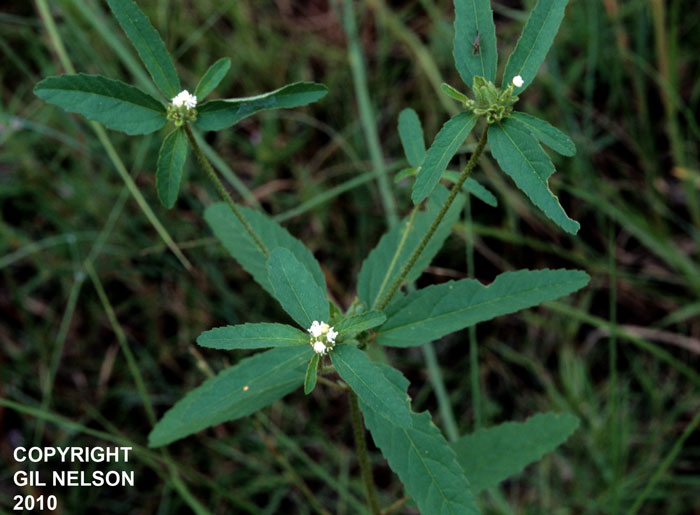Croton glandulosus
| Croton glandulosus | |
|---|---|

| |
| photo by Gil Nelson | |
| Scientific classification | |
| Kingdom: | Plantae |
| Division: | Magnoliophyta - Flowering plants |
| Class: | Magnoliopsida – Dicotyledons |
| Order: | Euphorbiales |
| Family: | Euphorbiaceae |
| Genus: | Croton |
| Species: | C. glandulosus |
| Binomial name | |
| Croton glandulosus L. | |

| |
| Natural range of Croton glandulosus from USDA NRCS Plants Database. | |
Common names: Vente Conmigo; Doveweed; Tooth-leaved Croton; Sand Croton
Contents
Taxonomic notes
Synonyms: none
Varieties: C. glandulosus Linnaeus var. septentrionalis Muller of Aargau
Description
This species is an annual forb/herb and subshrub that is a member of the Euphorbiaceae family.[1] Leaves alternately arranged, serrate, and lanceolate to ovate shape. Flowers unisexual and borne on a terminal raceme. Fruit type is a capsule.[2]
Distribution
Croton glandulosus is native throughout tropical and subtropical America.[3] It is introduced as well as native in the eastern and central United States, from Pennsylvania and New Jersey south to Florida as well as west to New Mexico, Kansas, Nebraska, South Dakota, and Minnesota. The species is also native to Puerto Rico and the U.S. Virgin Islands.[1]
Ecology
Habitat
It can be found in mid-grass prairie communities.[4] It can also be found in longleaf pine communities, though it is not as common since they're dominated by perennial species.[5] This species has been observed in sandy and sandy loam soils of turkey oak ridges, open fields and clearings, wet borders of swamps, cabbage palm hammocks, dunes, and the ecotone between trees and shoreline of beaches. This species also occurs in human disturbed areas such as grassy highway medians, grassy edges of parking lots, along railroad tracks, waste areas, sandy roadsides, corn fields, and citrus groves.[6]
Associated species includes Quercus laevis, Q. geminata, Baptisia, Selaginella, Polygonella, Commelina, Pinus palustris, Haplopappus divaricatus, Pityopsis, Palofoxia, Ambrosia, and Conyza.[6]
Phenology
It is seasonal; it is mainly found from May to December, peaking in September in a study at Padre Island.[4] It has been observed flowering and fruiting June through October with peak inflorescence in June and August, and fruiting in December.[6][7]
Seed dispersal
This species is thought to be dispersed by ants and/or explosive dehiscence. [8]
Seed bank and germination
It germinates after fire.[4]
Fire ecology
It is included in the flowering plant survery – post burn – in Heuberger’s study[9]
Pollination
The following Hymenoptera families and species were observed visiting flowers of Croton glandulosus at Archbold Biological Station: [10]
Sphecidae: Cerceris blakei, Philanthus ventilabris
Use by animals
C. glandulosus consists of approximately 5-10% of the diet for terrestrial birds.[11]
Conservation and management
C. glandulosus is listed as threatened by the Ohio Department of Natural Resources. It is also considered a species that can be weedy or invasive by the Southern Weed Science Society.[1]
Cultivation and restoration
Photo Gallery
References and notes
- ↑ 1.0 1.1 1.2 USDA, NRCS. (2016). The PLANTS Database (http://plants.usda.gov, 22 April 2019). National Plant Data Team, Greensboro, NC 27401-4901 USA.
- ↑ [[1]] Lady Bird Johnson Wildflower Center. Accessed: April 22, 2019
- ↑ Weakley, A. S. (2015). Flora of the Southern and Mid-Atlantic States. Chapel Hill, NC, University of North Carolina Herbarium.
- ↑ 4.0 4.1 4.2 Lonard, R. I., F. W. Judd, et al. (2004). "Recovery of vegetation following a wildfire in a barrier island grassland, Padre Island National Seashore, Texas." Southwestern Naturalist 49: 173-188.
- ↑ Simkin, S. M., W. K. Michener, et al. (2001). "Plant response following soil disturbance in a longleaf pine ecosystem." Journal of the Torrey Botanical Society 128: 208-218.
- ↑ 6.0 6.1 6.2 Florida State University Robert K. Godfrey Herbarium database. URL: http://herbarium.bio.fsu.edu. Last accessed: June 2014. Collectors: Loran C. Anderson, G. Avery, D. Burch, Andre F. Clewell, Delzie Demaree, R. F. Doren,S. F. da Fonseca, B. J. Frier, Robert K. Godfrey, H. S. Irwin, D. Jones, Walter S. Judd, Beverly Judd, Gary R. Knight, R. Komarek, Robert Kral, Mabel Kral, Merle Kuns, O. Lakela, Robert L. Lazor, Karen MacClendon, F. Matthews, Sidney McDaniel, Richard S. Mitchell, Leon Neal, J. B. Nelson, R. A. Norris, Gwynn W. Ramsey, R. Reis dos Santos, Cecil R. Slaughter, R. Souza, V. I. Sullivan, Amanda R. Travis, Edwin L. Tyson, and D. B. Ward. States and Counties: Florida: Bay, Calhoun, Citrus, Collier, Dade, Franklin, Hernando, Highlands, Jackson, Jefferson, Lafayette, Lake, Leon, Levy, Liberty, Madison, Martin, Nassau, Okaloosa, Pinellas, Polk, Putnam, Seminole, St. Johns, Taylor, Volusia, and Wakulla. Georgia: Thomas. Other Countries: Honduras, Bolivia, and Brazil.
- ↑ Nelson, G. PanFlora: Plant data for the eastern United States with emphasis on the Southeastern Coastal Plains, Florida, and the Florida Panhandle. www.gilnelson.com/PanFlora/ Accessed: 22 APR 2019
- ↑ Kirkman, L. Katherine. Unpublished database of seed dispersal mode of plants found in Coastal Plain longleaf pine-grasslands of the Jones Ecological Research Center, Georgia.
- ↑ Heuberger, K. A. and F. E. Putz (2003). "Fire in the suburbs: ecological impacts of prescribed fire in small remnants of longleaf pine (Pinus palustris) sandhill." Restoration Ecology 11: 72-81.
- ↑ Deyrup, M.A. and N.D. 2015. Database of observations of Hymenoptera visitations to flowers of plants on Archbold Biological Station, Florida, USA.
- ↑ Everitt, J.H., D.L. Drawe, and R.I. Lonard. 1999. Field guide to the broad leaved herbaceous plants of South Texas used by livestock and wildlife. Texas Tech University Press. Lubbock.